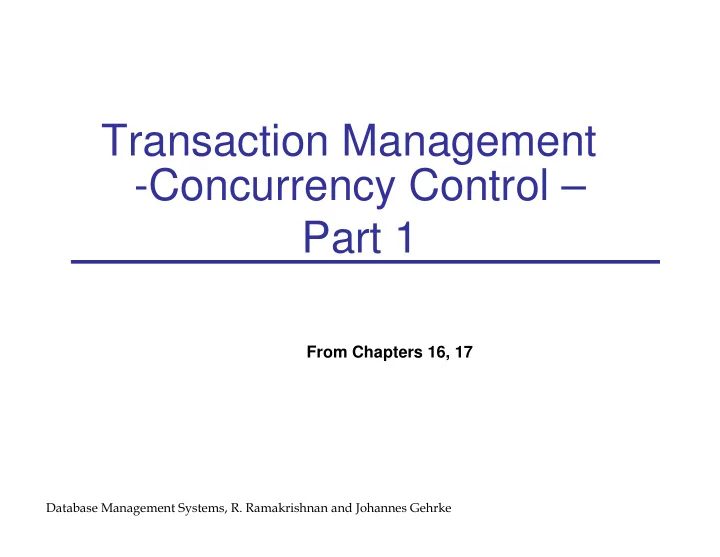

Transaction Management -Concurrency Control – Part 1 From Chapters 16, 17 �������������������������������������������� �������������������
Motivation � Concurrent execution � Why is this desirable? � Crash recovery � Crashes not desirable but unavoidable! � Transactions �������������������������������������������� �������������������
Transactions: The ACID properties � A A tomicity: � � C C onsistency: � � I I solation: � � D D urability: � �������������������������������������������� �������������������
Transactions API Client Application Database System ����������������� ����������� ��� ���!����������"#�����$ �%�������"#�����& ODBC/JDBC ' Connection (�������������� �������������������������������������������� �������������������
Outline – Concurrency Control � Examples � Formal definition of serializability � Possible solutions to concurrent execution anomalies �������������������������������������������� �������������������
Goal of Concurrency Control � Transactions should be executed so that it is as though they executed in some serial order � Weaker variants also possible �������������������������������������������� �������������������
Example User 1: Buy 10 Snicker bars User 2: Buy 2 Gatorade bottles Possible order of processing at DB server: �������������������������������������������� �������������������
Anomalies (Lost Update) User 1: Buy 10 Snicker bars User 2: Buy 2 Snicker bars Order of processing at DB server: �������������������������������������������� �������������������
DBMS’s View U1: Read nb Snickers T1: R(Snickers) U2: Read nb Snickers T2: R(Snickers) U1: Reduce count Snickers by 10 T1: W(Snickers) U1: Write new nb Snickers back T1: COMMIT U2: Reduce count Snickers by 2 T2: W(Snickers) U2: Write new nb Snickers back T2: COMMIT time T1: R(S) W(S) Commit T2: R(S) W(S) Commit time �������������������������������������������� �������������������
Inconsistent-Read Anomalies � Dirty reads – read uncommitted data � T1: R(A), W(A), R(B), W(B), Abort � T2: R(A), W(A), Commit � Unrepeatable reads � T1: R(A), R(A), W(A), Commit � T2: R(A), W(A), Commit �������������������������������������������� �������������������
Class Exercise � Transaction Steps � Possible Schedule � Possible Problems � T1: Transfer money from savings to checking � T2: Add interest for savings account �������������������������������������������� �������������������
Outline � Examples � Formal definition of serializability � Possible solutions to concurrent execution anomalies �������������������������������������������� �������������������
Scheduling Transactions � Serial schedule: � Equivalent schedules : � Serializable schedule : �������������������������������������������� �������������������
Conflict Serializable Schedules � Two schedules are conflict equivalent if: � Schedule S is conflict serializable if S is conflict equivalent to some serial schedule �������������������������������������������� �������������������
Example � A schedule that is not conflict serializable: )�* � +!��, +!���� � �!��, �! )$* � +!��, +!��� �!��, �! + )� )$ ���������������� � � The cycle in the graph reveals the problem. The output of T1 depends on T2, and vice-versa. �������������������������������������������� �������������������
Dependency Graph � Dependency graph : One node per Xact; edge from Ti to Tj if Ti precedes and conflicts with Tj � 2 actions conflict if at least one is a write � Theorem: Schedule is conflict serializable ________ its dependency graph is acyclic � Certain serializable executions are not conflict serializable! �������������������������������������������� �������������������
Example )�*�� +! , +! )$* , +! )&* , +! )�*�� +!�, +! )$* , +! )&* , +! �������������������������������������������� �������������������
Outline � Examples � Formal definition of serializability � Possible solutions to concurrent execution anomalies �������������������������������������������� �������������������
Resource Locking � Locking: prevents multiple applications from obtaining copies of the same resource when the resource is about to be changed � Lock granularity - size of a locked resource � Types of lock � Exclusive lock (X) � Shared lock (S) �������������������������������������������� �������������������
Explicit Locks User 1: Buy 10 Snicker bars User 2: Buy 2 Snicker bars User 1: User 2: Lock Snickers Lock Snickers Read nb Snickers (ns=500) Read nb Snickers (ns2=500) Reduce count Snickers by 10 (ns=490) Reduce count Snickers by 2 (ns2=498) Write new nb Snickers back (ns=490) Write new nb Snickers back (ns2=498) Order of processing at DB server: �������������������������������������������� �������������������
Class Exercise – Place Locks � T1: R(Sa), W(Sa), R(Ch), W(Ch), Abort � T2: R(Sa), W(Sa), C �������������������������������������������� �������������������
Strict Two-Phase Locking � Strict two-phase locking � Locks are obtained throughout the transaction � All locks are released at the end of transaction (COMMIT or ROLLBACK) �������������������������������������������� �������������������
Strict 2PL Example � Not 2PL � Strict 2PL � X(A) � X(A) � R(A) � R(A) � W(A) � W(A) � Rel(A) � X(B) � X(B) � R(B) � R(B) � W(B) � W(B) � Rel(B,A) � Rel(B) �������������������������������������������� �������������������
Lock Management � Lock and unlock requests are handled by the lock manager � Lock table entry: � Number of transactions currently holding a lock � Type of lock held (shared or exclusive) � Pointer to queue of lock requests � Locking and unlocking have to be atomic operations � Lock upgrade: transaction that holds a shared lock can be upgraded to hold an exclusive lock �������������������������������������������� �������������������
Recommend
More recommend